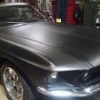Sign in to follow this
Followers
0

How stiff should a diaphragm pressure plate clutch setup be?
By
DRASTiK, in 1969-70 Technical Forum

By
DRASTiK, in 1969-70 Technical Forum